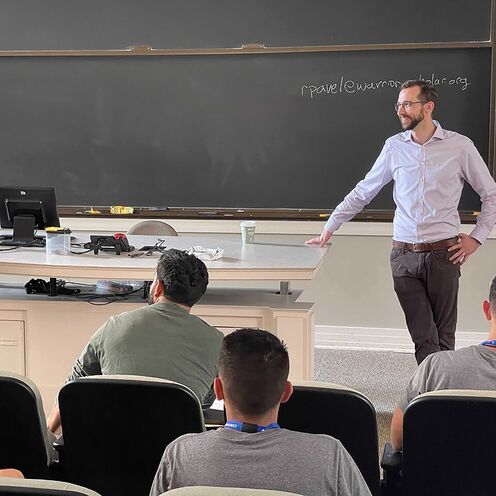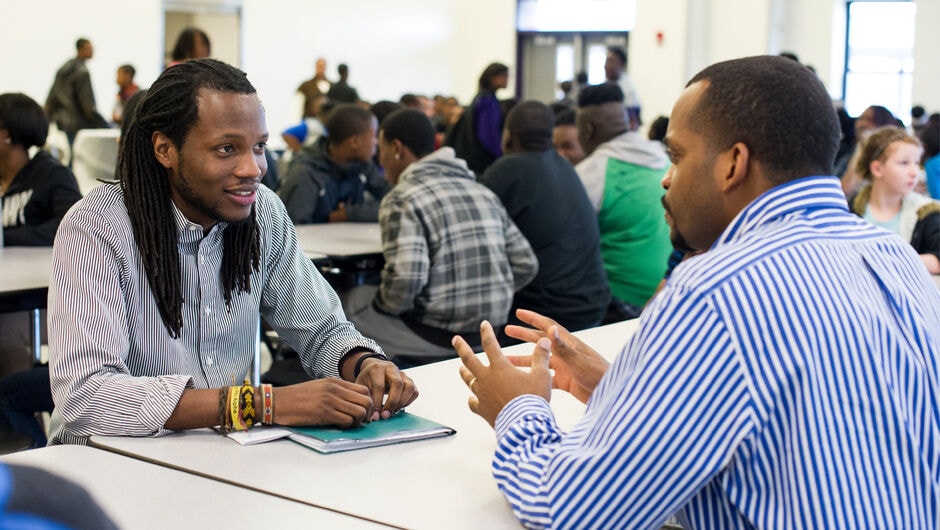
Veterans, Your Next Act of Service Could Be in the K-12 classroom
Every year, roughly 200,000 service members separate from the military, many searching for that next purpose-driven pursuit. What if more of them stepped into the 300,000 unfilled jobs in schools across the country?
“The time is short; the need is great.” A mentor shared these words with me when I started teaching, and I have yet to find something that better encapsulates my classroom experience.
I’ve had some tough jobs. I spent five years in the Marine Corps and deployed a couple of times to Iraq, working as an Arabic translator. I also dabbled in corporate litigation before finding my calling leading a nonprofit that equips veterans for success in college. Nothing I have done compares to the two years I spent as a Teach For America corps member.
Every year, roughly 200,000 service members separate from the military, many searching for that next purpose-driven pursuit. What if more of them stepped into the 300,000 unfilled jobs in schools across the country, whether through alternative certification or traditional degree paths? What better act of continued service than to meet the challenges of teaching head on?
Stereotypes of veterans can be deeply problematic – I cringe every time I hear someone refer to all veterans as heroes or victims of post-traumatic stress – but there are some commonalities that make veterans well equipped for classroom service. The vast majority of us have had to develop resiliency from our time in the military, frequently dealing with less than ideal resources to accomplish the mission, often by developing inventive solutions and relying on teamwork to get the job done.
I had to put all of this to work in the classroom. After earning my degree, I was eager to find a job where I could continue to serve and make a meaningful impact. The TFA mission of serving alongside diverse leaders to end educational inequity resonated deeply with me, so it was an easy decision to apply.
A few months later, fresh out of intensive summer training in instructional design and classroom management, I gave a reading assessment to my ninth graders to kick off the year. The results left me speechless. Of the roughly 30 students in the class, the average reading level was between the fourth and fifth grade, with some students testing at the kindergarten range and a couple as high as grade 12.
I had little time to stop and regroup; the bell rang, one group of students left, and seemingly seconds later the next group arrived. When the school days were extended and summer break canceled to carve out more instructional time, the lines from one year to the next blurred together. But my students and I persevered, and they made steady improvements in reading and writing throughout our time together.
Get more articles like this delivered to your inbox.
The monthly ‘One Day Today’ newsletter features our top stories, delivered straight to your in-box.
Content is loading...
I had underestimated both the need and the challenges of teaching. Part of the pressure comes from internalizing how much the work really matters. My students didn’t have time for me to figure out how to teach; they just needed me to do it. If I did a lackluster job, that wouldn’t just reflect negatively in a performance review, it would tangibly and directly affect the lives of over 100 young adults.
While I am proud that I completed my two-year teaching commitment, the experience gave me enormous, lifelong respect for teachers who are in it for the long haul. Teaching is an undervalued and under-resourced profession. The formal training I received in the classroom was essential, but so too was the mentorship I received from the experienced teachers to my left and my right who invested time to help make me effective. I wouldn’t have made it without them.
Interested in Joining Teach For America?
I also gained vital perspective on the education system and the deep inequalities in our country. Those perspectives continually inform my current work with veterans in higher education.
To be clear, I am not saying that veterans are automatically qualified to teach just by virtue of their military service. A bachelor’s degree, initial teaching certification, and rigorous training should always be prerequisites to teach. But there are programs that can help, like Warrior-Scholar Project for degree completion and Teach For America and Troops to Teachers for alternative certification.
The thing about enormous need is that there is also enormous opportunity for impact. We’re in a defining moment for our education system, and I hope my fellow veterans rise to the occasion.
Featured image at top of page: Ryan Pavel (Detroit '12), CEO of the Warrior-Scholar Project, met with veterans at Princeton University in 2022 to discuss how to channel military experience into excellence in the college classroom and how to connect education to career goals.
Editor's Note: The following story is being reprinted with the permission of Stars and Stripes, which retains all rights. To read the original story, please visit https://www.stripes.com/opinion/2022-12-12/veterans-teacher-k-12-classroom-8394760.html
We want to hear your opinions! To submit an idea for an Opinion piece or offer feedback on this story, visit our Suggestion Box.
The opinions expressed in this piece, and all others in our Opinion section, represent those of the authors and do not necessarily reflect the views and opinions of the Teach For America organization.
Sign up to receive articles like this in your inbox!
Thanks for signing up!
Content is loading...







